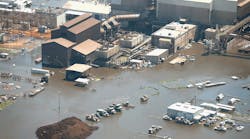Huge clean-up efforts are underway along the Gulf Coast, an industrial powerhouse for the entire United States. The region is home to nearly a quarter of U.S. oil refining capacity and half of the nation’s chemical manufacturing.
Hurricane Harvey sidelined dozens of these refineries and factories. Companies are moving quickly to get their facilities up and running. Fair enough: an idle business means lost paychecks, lost profits and lost tax revenue. And consumers may face long wait times and higher prices for gasoline and other essential products.
We all want full gas tanks and as little interruption as possible in the flow of consumer goods. But let’s not forget the impact on workers. Employers will want to move fast to ramp up production – but if they move too fast, workers will face unnecessary risks.
Residents, local contractors and do-it-yourselfers also face myriad hazards. Lab tests of water in flooded homes, performed by the Houston Health Department, Baylor Medical College and Rice University, show alarmingly high levels of e-coli and other contaminants.
Dangerous Business
Re-starting production and rebuilding homes after a disaster is dangerous business, as thousands learned from bitter experience following 9/11, Hurricane Katrina, Hurricane Sandy and other traumatic events.
Buildings may be brittle and subject to collapse. Wet surfaces present a slip-and-fall hazard. Flood waters may contain unknown toxic hazards. Mold, sewage and contaminated air can cause both acute and long-term injuries and illnesses.
Most of us instinctively run away from danger. Gulf Coast industrial workers and laborers from the area’s informal workforce are now being hired to go directly towards danger. Employers and workers need to walk – not run – and incorporate safety into everything they do.
Anybody working on their own home, or tackling a clean-up for friends and family, also should take precautions and wear protective boots, gloves and masks. Don’t keep working if you feel sick; the job can wait and your health is more important.
Some key points for workers assigned to homes and businesses:
- Avoid mandatory overtime: There will be demands for long hours, but excessive mandatory overtime can lead to exhaustion. You don’t want to be overtired when working in a hazardous environment.
- Incorporate safety into the work: This is no time to “just get ‘er done.” Safety controls and processes exist for a reason. When cleaning up after a disaster, listening to worker concerns is extremely important.
- Monitor toxic exposure: There’s a temptation to “tough it out” during a critical clean-up. That’s a bad idea, especially when working near toxic air and water. Exposures must be strictly monitored and work stopped when there are signs of danger.
- A healthy workforce is more important than bonus money: It’s common to offer financial incentives for a quick re-start after a major disruption. But this can create temptation to cut corners, ignore hazards and make mistakes that put lives at risk. Contractors who may be unfamiliar with a facility can pose an extra risk to themselves and others.
- Process safety procedures are more important than ever. Process safety is the mix of engineering, management controls and worker participation used to reduce risk during complex operations. It may slow things down to implement a thorough safety system approach, but now is the time to pay attention to the whole picture. That includes getting workers involved in assessing risk and reducing hazards.
The aftermath of Hurricane Harvey is not the first time industrial workers, contractors and homeowners will have to manage risk to perform critical repair work, and it won’t be the last, as the ongoing reality of climate change likely will result in more frequent and severe weather events in the years to come.
Let’s build on what we know and do the job right. Because people – not oil, chemicals, plastics or buildings – are our most precious resource.
About the authors: Marianela Acuña Arreaza is executive director of the Houston-based Fe y Justicia Worker Center. Jessica Martinez is co-executive director of the National Council for Occupational Safety and Health. They recently coordinated a three-day “Train-the-Trainer” session in Houston, providing worker advocates information on safe clean-up procedures.
